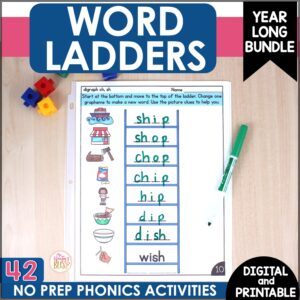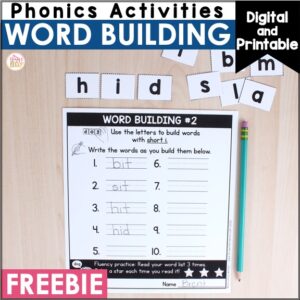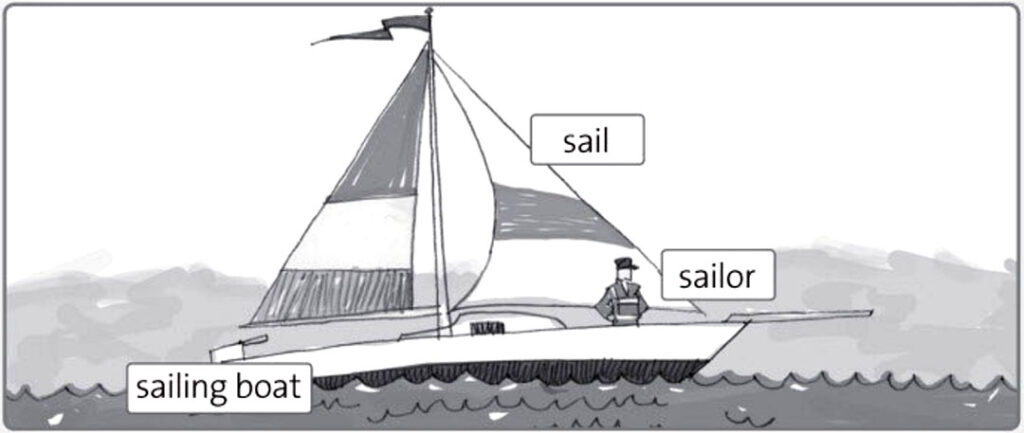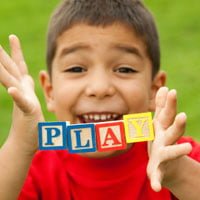
As you learned last time, Charlotte Mason’s reading lessons used two approaches: sight words and word-building. To add variety and keep things interesting for the student, Charlotte alternated lessons between the two. Last week we described how to do a sight-word lesson. This week let’s take a look at a word-building lesson.
Word-building lessons are a great tool to help your child learn to break words down into their smaller components. These type of lessons are also a wonderful opportunity to let your child discover that not every word with the same letter combination will be pronounced in the same way. Yet all of this is done in an interesting and gentle way. Here’s how.
For the word-building lessons, you’ll need the loose letters and a chalkboard or white board. You might also want a blank notebook or small journal to use as your child’s Word Notebook. Let him decorate the cover, if he would like to.
- Write on the board one of the words your child learned in the previous sight-word lesson. For our example here, we’ll use “twinkle.” Ask your child to read the word.
- Erase the word on the board and see if your child can spell it from memory with his loose letters. If not, simply write it on the board again so he can look at it as he creates it with his loose letters.
- Write the word on the board, if it is not there already. Say the word slowly and ask, “What do we have left if we take away tw?” Erase the beginning letter(s) and help your child get “inkle.”
- Ask, “What would you add to “inkle” to get “tinkle?” Have your child add a “t” to create the new word with his loose letters. Use the same process to make “sprinkle” and “wrinkle” and any other “inkle” derivatives that you can think of. Remember, you don’t have to do every possible combination. Choose words that will mean something to your child, and discuss them as you go along.
- Write on the board all the words you make, forming them into a list for your child to read aloud. Review this list in various orders as you go through the lesson.
- Repeat the process with all the sight words your child learned last time. In this case, you would do word-building with “star” and “little,” as well. “Star” could produce “jar, bar, car, far, mar, par, tar, war, scar, spar, char,” etc. From “little” you could make “brittle, spittle, whittle.”
- Let your child notice exceptional pronunciations within the word lists; for example, “war” is pronounced differently than “jar, bar, car” in the list above. Don’t feel like you have to explain the reason a word is pronounced differently even though it looks the same. Simply point out how each word is pronounced, and your child will form his own mental guidelines.
- Use all the words your child has learned to create more sentences. As you progress through the lessons, you’ll have a large storehouse of words to use. Write new sentences on the board and have your child read them aloud.
- You can also keep a record of all the words your child has learned by writing them in a notebook or journal. Use the Word Notebook for review and to celebrate his progress.
What about the Phonics Rules?
You may have noticed that we haven’t said a word about phonics rules in all these reading lessons. That’s because Charlotte did not emphasize them. Yes, she included some phonics guidelines as they would be helpful to the child, but she did not teach them as rules with multiple exceptions. She encouraged the child to form his own general mental guidelines based on his experiences with sight words and word-building. She trusted the children to deal with language capably.
The fact is, we become so familiar with the words we see often, that we recognize them at sight, even whn they are mssng lttrs. And that is what makes a fluent reader: recognizing words quickly as you see them. When we come across an unknown word, we try to figure it out based on components that we recognize. And those are exactly the strategies that Charlotte’s reading lessons emphasize.
Yes, phonics is one tool we can use to help a child get to the place where he will recognize words as he is reading. Studies have shown that phonics guidelines can be very effective when introduced as needed, rather than as a list of rules to be memorized. But keep in mind that phonics are not the only tool we have.
With Charlotte Mason-style reading lessons, we can give our children multiple tools to help them learn to recognize words and to enjoy reading.
Next time we will tell you about an exciting new resource created to make it easy for you to give your child Charlotte Mason-style reading lessons!
Word building is a critical phonics activity. Students will develop word awareness skills as they explore and play with letter sounds to build words. Make sure to download the letter building cards and word building activities in this post.
One thing I love about teaching is that there is always the opportunity to learn, grow and become better. This past year I have spent a lot of time reading the work of Wiley Blevins. I’ve learned so much about phonics instruction and come to realize that there are aspects of the way I taught phonics that I would now change and improve.
One of my main takeaways from Blevins’ book, A Fresh Look at Phonics, is the importance of providing students with lots of opportunities for review and repetition in order to ensure they actually master the skills that we teach!
I realized that in my own teaching (and I confess!) I was guilty of exposing my students to a phonics skill, taking them through my weekly word study routine, and then moving onto the next skill the following week. I’m afraid I wasn’t giving them enough practice to ensure mastery.

Even if you know you need to provide this extra practice, it can be a challenge to come up with activities that effectively meet your needs. In his book Phonics from A to Z, Wiley Blevins suggests using word sorts and word building activities as a way to allow students to explore and play with letter sounds.
In my last blog post I shared all about word sorts, so today I’m excited to provide you with information about word building activities and share some resources to help get you started with these critical routines.
What are Word Building Activities?
In word building, students are given a set of letter cards and asked to create a series of words in a specified sequence. Usually, each new word varies by only one sound-spelling from the previous word. For example, students may build the following words in sequence: sat, hat, hop, mop. Each new word varies from the one before it by only one sound-spelling.

There are two types of word building activities, each with their own instructional purpose.
- Word Building: Blending Focus In this type of word building students are asked to make a word, such as cat. Then they would be asked to change the letter c to s and read the new word formed. The goal here is for them to blend, or sound out the new word. You can include many words with the new target phonics skill and also include previously taught skills.
- Word Building: Word Awareness Focus Here, students are asked to make a word such as cat, and then told to change it to hat. This requires a lot more thinking than blending-focused work. Students have to think about how the two words are different and which sound must be changed in order to form the new one.
Both of these word-building activities can be done with the same set of words, so incorporating both into your week gives your students good practice and saves you planning time!
Word Building Routines
The routine for word building is simple! First, introduce the task by naming it and explaining the purpose.
Next, MODEL! Place letter cards in a pocket cart to form the first word you are building. Model sounding out the word. As you build new words, be sure to include the new target sound-spelling as well as words with review sound-spellings. Use minimal contrasts to ensure students fully analyze the words and notice their unique differences. For example, sat/hat, mop/map, mad/made, cot/coat.
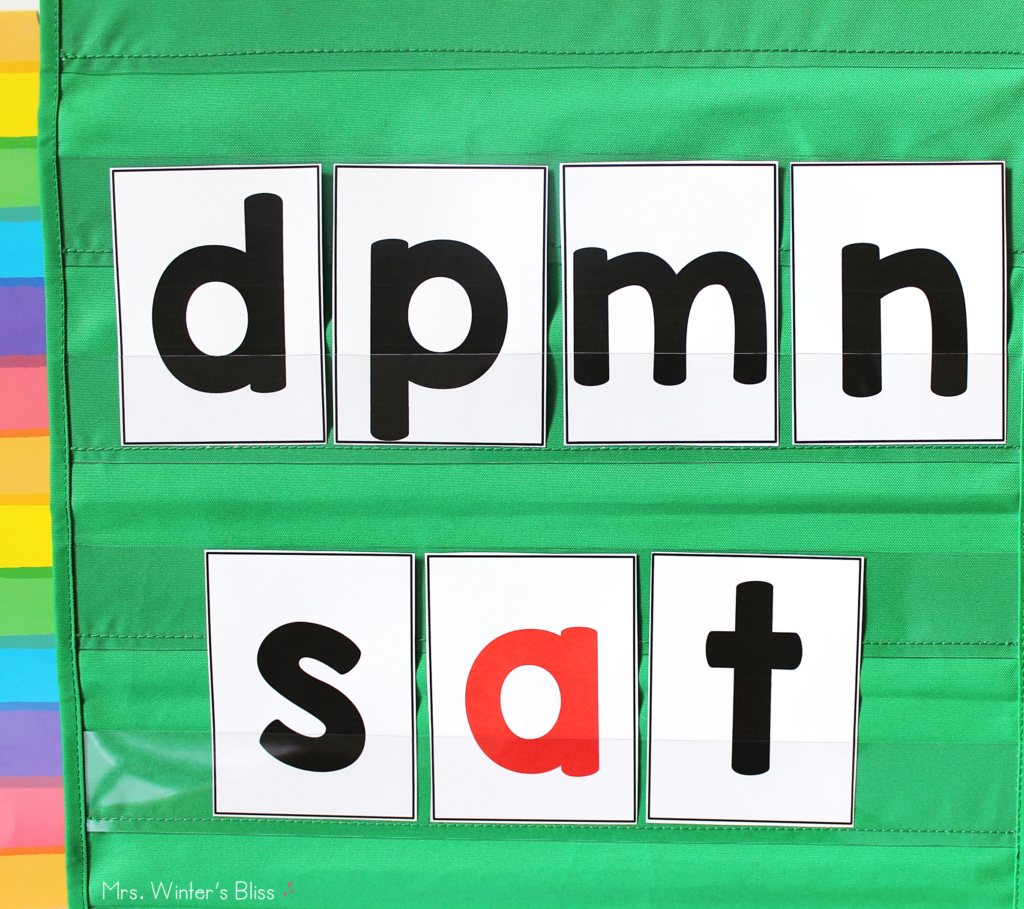
Download a set of these large letter cards for your pocket chart here!
Finally, provide opportunities for guided and independent practice. Continue to change one or more letters in a word and have students chorally blend the new word formed.

Make sure to have a word list prepared before the lesson in order to keep on track with the focus skill and review skills previously taught.

If you are working on word awareness (instead of blending) tell students what the next word is in the sequence and have them form it on their own. After giving them time, form the new word on the pocket chart and model your thinking aloud.
If you have fairly strong word building and word sorts routines in place, an engaging exercise to continue the development of word awareness is Word Ladders.
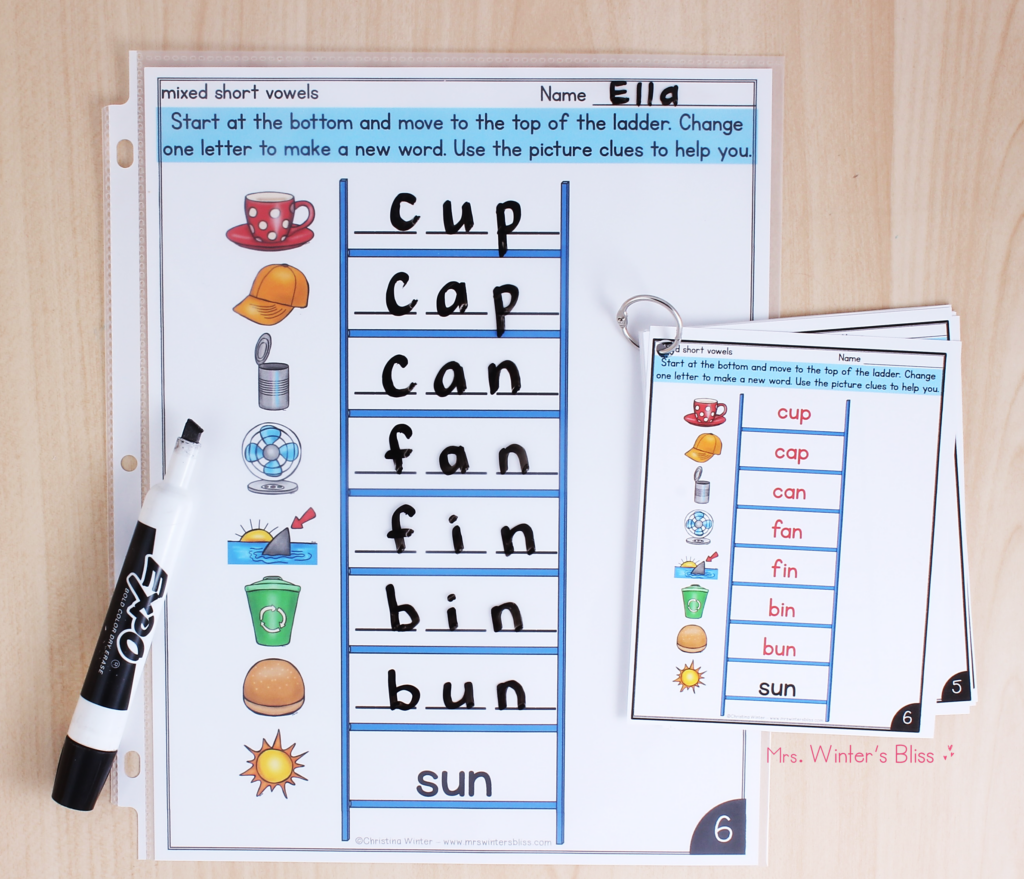
Word ladders are a fun and challenging word activity for students, and a great one to use towards the end of the week once they have had a lot of exposure to the word pattern. Since word ladders are self-checking they are perfect to use in an independent literacy center.
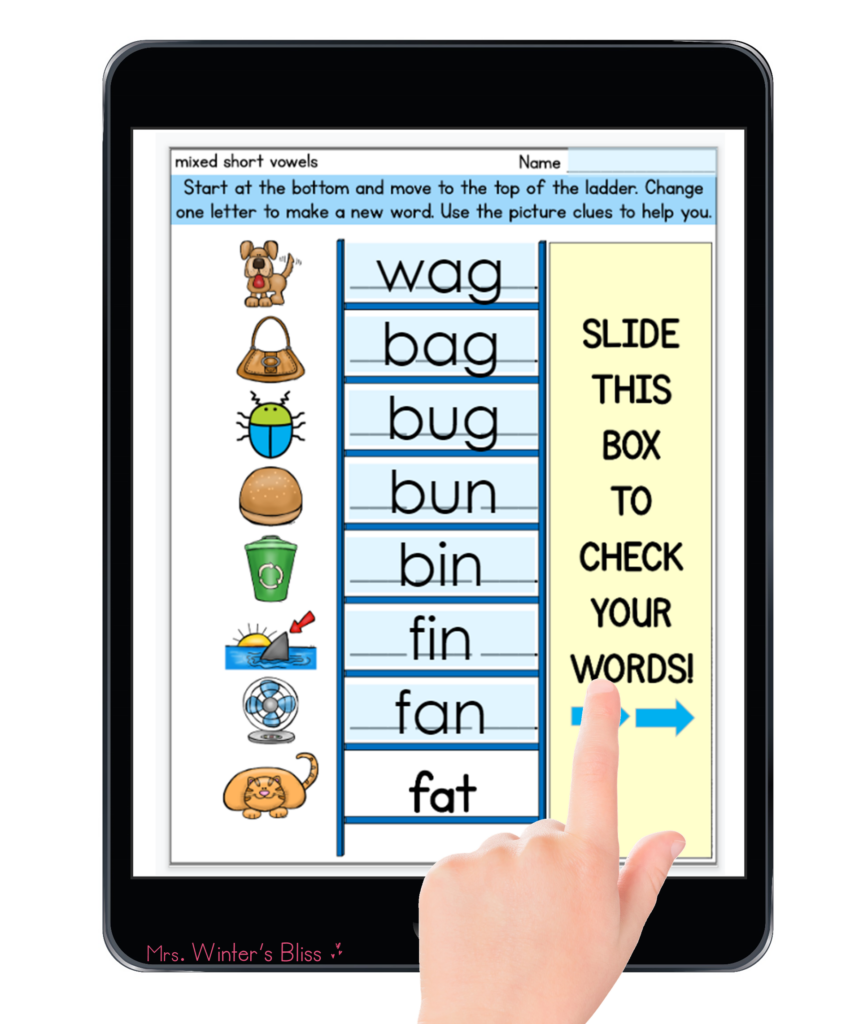
-
Phonics Word Building – Printables + premade Seesaw & Google
Product on sale
$24.50
-
Word Ladders Phonics BUNDLE – digital & printable
Product on sale
$10.00
Rated 5.00 out of 5 based on 2 customer ratings
Phonics Word Building Activities
Today I’m thrilled to share with you my very own Phonics Word Building Activities! These DIFFERENTIATED activities are both printable and digital so you can use them in the classroom or for distance learning with Google Classroom & Seesaw!
Students will listen to the AUDIO directions (from yours truly!) and then build words in a specified sequence. Each new word only varies by one sound spelling from the previous word. Students press the audio button to hear me state the word to build, blend the phonemes of the word, say the word again, and use it in a sentence to develop vocabulary.
This resource includes:
- 31 teacher-directed digital word building lessons
- 31 printable word building lessons
- master word list
Each of the 31 lessons focuses on one phonetic pattern:
- Short Vowel (CVC) Words
- Digraphs
- Blends
- Long Vowels
- Diphthongs
- R-Controlled Vowels
- Complex Vowels
Get started now by downloading your FREE phonics word building activities here:
-
FREE Phonics Word Building – Printables + premade Seesaw & Google
$0.00
Rated 4.75 out of 5 based on 4 customer ratings
Word Ladders
This resource includes both printable and digital word ladders that require students to think critically to figure out the next word to build, using letter or picture clues for support! Students will change just one letter to build a new word.
Included in this resource are 42 word activities- enough to last you the entire year!
Included Phonics Patterns:
- CVC Words
- Digraphs
- Blends
- Long Vowels
- Diphthongs
- R-Controlled Vowels
- Complex Vowels
Both of the Phonics Word Building activities and the Word Ladders provide students explicit and systematic practice. All of the activities in both of the resources are based on Wiley Blevins’ recommended scope and sequence for K-2 students. You can be confident that they are developmentally appropriate and provide the scaffolding students need for mastery.
EASY TO PREP AND MANAGE!
One of the major pitfalls with some word sorts is that they often require a lot of small pieces of paper, letter cuts, or word cards. They can take a long time to prep, distribute, and collect!
But NOT these activities! The printable pieces require very few cuts for students. There will be NO TIME wasted dealing with materials!
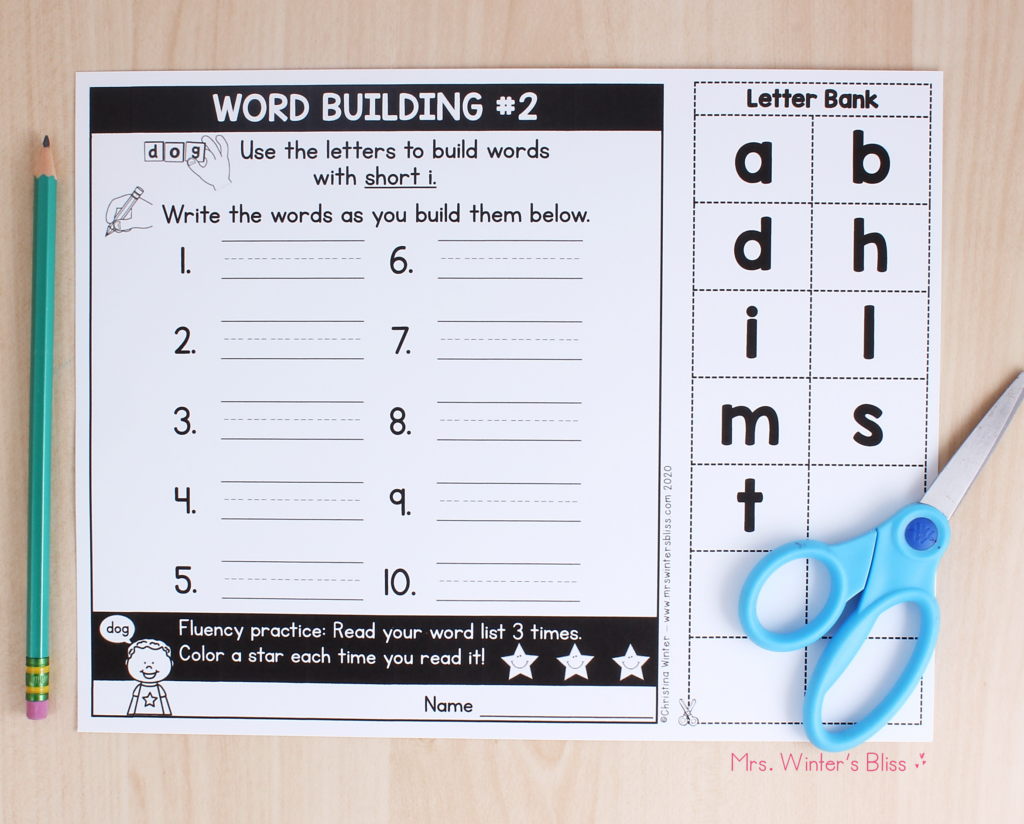
The digital versions have been PRELOADED for you. With 1 click you add them to your Seesaw library or Google Drive and then you can assign them to your students for remote learning or individual centers!
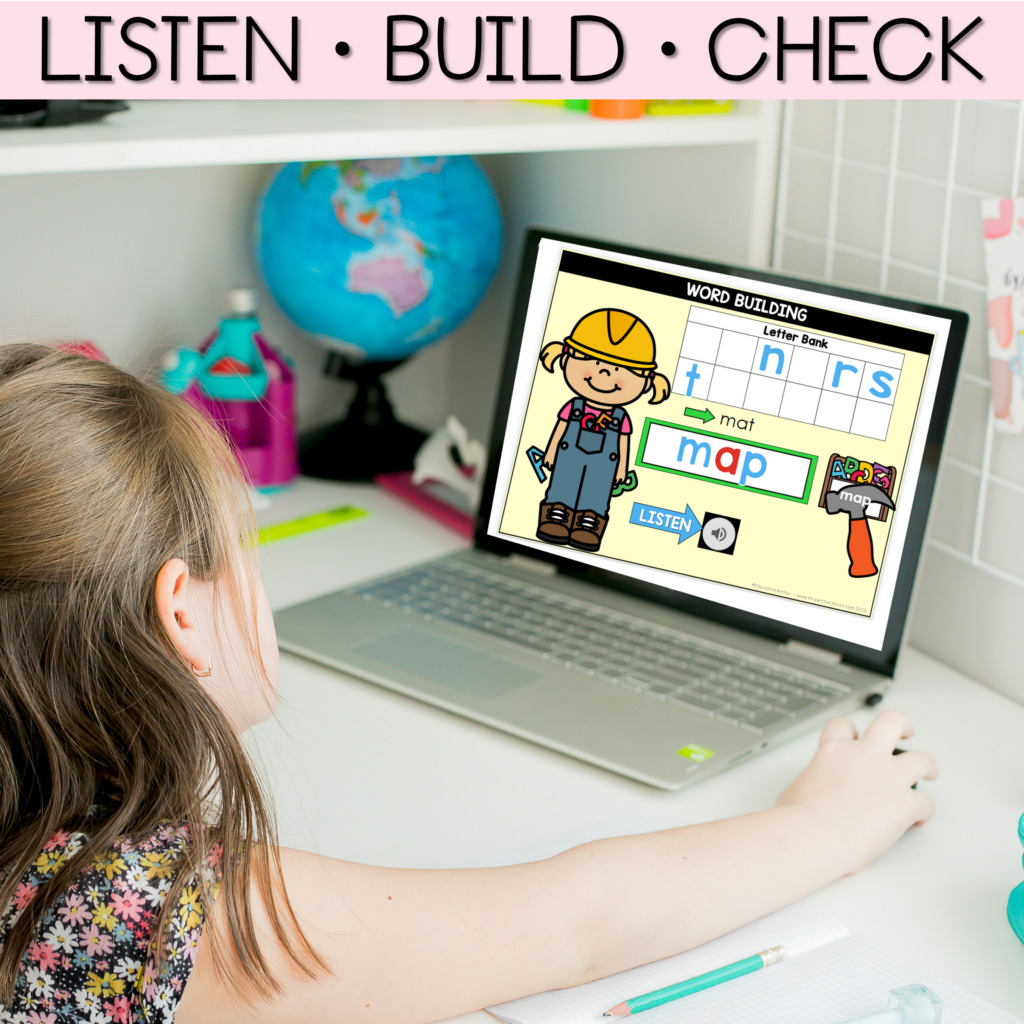
Another BONUS is that the structure of each activity in both of these resources remains the same. This saves you from having to explain and model every time you assign one! Once your students have successfully completed one, you can be sure they’ll be able to independently work through the rest at whatever pace you assign them!
I hope the Phonics Word Building Activities and the Word Ladders I’ve shared today will help you provide your students with meaningful practice that will help them to develop their word awareness and master their phonics skills!
–PIN for LATER–

-SHOP THIS POST-
-
Phonics Word Building – Printables + premade Seesaw & Google
Product on sale
$24.50
-
Word Ladders Phonics BUNDLE – digital & printable
Product on sale
$10.00
Rated 5.00 out of 5 based on 2 customer ratings
1. Write the noun form of these verbs. Some are the same as the verb.
|
Verb |
Noun |
|
1 complete |
completion |
|
2 achieve |
|
|
3 need |
|
|
4 dream |
|
|
5 argue |
|
|
6 fail |
|
|
7 translate |
|
|
8 erupt |
|
|
9 rescue |
Answer
2 achievement 3 need 4 dream 5 argument
6 failure 7 translation 8 eruption 9 rescue
2. Complete the text with the noun form of the verbs in brackets. You may need the plural form.
Last year, at the age of seventeen, Mike Perham became the youngest sailor to complete a 1……………………………. (circumnavigate) of the world alone. But this year, two sixteen-year-old girls are beginning separate 2……………………………. (attempt) to beat his record. Last year, a thirteen-year-old Dutch girl, Laura Dekker, was finishing her 3……………………………. (prepare) for the same journey when a children’s court stopped her. Now aged fourteen, she’s trying again. It seems that many teenagers today aren’t interested in the normal forms of 4……………………………. (entertain) and 5……………………………. (relax), like video games and sports. They want 6……………………………. (experience) that can really excite their 7……………………………. (imagine) and also help with the 8……………………………. (develop) of personal skills. So they choose 9……………………………. (explore). Their amazing 10……………………………. (accomplish) certainly look good on their CVs when it’s time to find 11……………………………. (employ). But for most of them, that probably isn’t the main 12……………………………. (motivate).
Answer
1 circumnavigation 2 attempts 3 preparations
4 entertainment 5 relaxation 6 experiences
7 imaginations 8 development 9 exploration
10 accomplishments 11 employment 12 motivation
3. Study the dictionary entries. Then answer the questions below.
1 Which noun is countable? …………………………….
2 Which noun is uncountable? …………………………….
3 Which noun has no definition? …………………………….
(Note: related nouns sometimes have no definition if the meaning is clear without one.)
4 Which entry has example sentences? …………………………….
5 Why are there two examples, not one?
…………………………….…………………………….
…………………………….…………………………….
Answer
1 explorer 2 exploration 3 exploration 4 explore
5 explore has multiple meanings. 6 exploration
VOCAB BOOST!
Sometimes pictures with labels can help you record and learn related words.
Verbs
sail – She sailed to America.
go sailing – We went sailing last summer.
4. Read the Vocab boost! box. Then complete the labels and add any other words you can. Use a dictionary to help you.
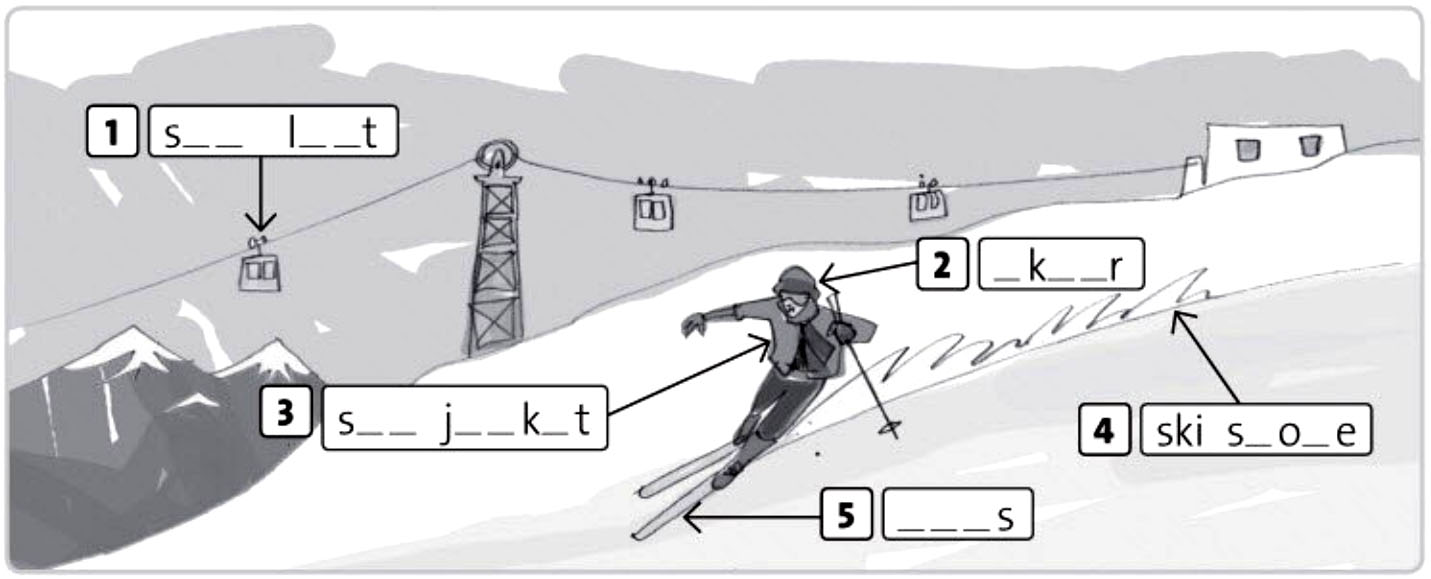
Answer
1 ski lift 2 skier 3 ski jacket 4 ski slope 5 skis
5. Complete the sentences using the noun or verb form of the word given in brackets.
1 The ……………………… of the new stadium will be next September. (complete)
2 It’s wonderful to ……………………… life in another country – you can learn so much about the world. (experience)
3 The books he wrote about famous mountain climbers are his greatest ……………………… (achieve)
4 She ……………………… to go running every day to prepare for the race. (need)
5 I don’t know what the ……………………… was about, but they’re friends again now. (argue)
6 Cars and lorries ……………………… over the bridge all day. (thunder)
7 Firefighters ……………………… their lives every day to save people and buildings. (risk)
8 I’m not sure what her ……………………… is, but she really wants to succeed. (motivate)
9 The ……………………… for our trip were quick because we only planned to stay for two nights. (prepare)
10 He is famous for his ……………………… as a mountain climber. (accomplish)
Answer
1 completion 2 experience 3 achievements
4 needs 5 argument 6 thunder 7 risk
8 motivation 9 preparation 10 accomplishments
YOU CAN WRITE 99% OF ENGLISH WORDS WITH WORDBUILDER! HERE ARE SOME EXAMPLES:
See those buttons under the graphemes? When students tap or slide their fingers over them,
the mouth in Word Builder articulates the speech sounds. Here’s another word:
Those symbols on the buttons (between the brackets) are the International Phonetic Alphabet (IPA) symbols for the speech sounds represented by the letters. They are the same symbols used in dictionaries to help people pronounce words correctly. They are not there for the students to learn! They are to help the person helping the student to become more aware of which speech sounds words are made up of. Here’s another word:
See the letter ‘e’ at the end of the word ‘spade’? That’s called a ‘silent e’ (sometimes called a ‘bossy e’ or ‘magic e’). Notice that there is no button under it. That’s because it doesn’t represent a sound in English. Instead, it causes the letter ‘a’ to represent its ‘long sound’ (‘a’ like in ‘alien, instead of ‘a’ like in ‘apple’). Word Builder can be used to teach similar patterns in spelling and reading. Here’s another word:
Notice that in the word ‘chips’ we use two letters, ‘ch’, to represent one speech sound. That type of spelling pattern is called a ‘consonant digraph’. Word Builder includes all of the common consonant digraphs in English, such as ‘sh’ (like in ‘ship’) and ‘th’ (like in ‘mouth’). It also includes all of the common vowel digraphs and r-controlled vowels, lke the ‘ea’ and ‘ore’ in this word:
Using graphemes — the building blocks of English spelling — you can also use Word Builder to write complex, longer words for advanced students, such as:
199 результатов для ‘wordbuilding’
wordbuilding
Случайное колесо
от Sweethometeacher
wordbuilding
Сопоставить
от Burmiki
wordbuilding
Сопоставить
от Meleks
Wordbuilding
Кроссворд
от Maryys
Wordbuilding
Классификация
от Sahandramedved
Wordbuilding
Сопоставить
от Catdrobinina
Wordbuilding
Случайное колесо
от Tulajane
Irregular Wordbuilding
Групповая сортировка
от Burutinairina
RNE wordbuilding
Викторина
от Burutinairina
wordbuilding questions
Случайные карты
от Hop
Gateway B1 U3 Negative prefixes
Угадай буквы
от Lizamoskvich
Pre-intermediate
wordbuilding
Gateway B1
Wordbuilding — prefixes
Групповая сортировка
от Yaotetoque
9-й класс
10-й класс
11 класс
Среднее образование
Техническое / профессиональное образование
Высшее образование
Adults
English
Wordbuilding: making adjectives
Групповая сортировка
от Hop
ADVERBS (wordbuilding)
Откройте поле
от Engtutor41rus
10-й класс
11 класс
English
English
ЕГЭ
ЕГЭ Английский язык
Wordbuilding 2
Сопоставить
от Nata75vin
wordbuilding EGE
Погоня в лабиринте
от Chayka17
Gateway B1U1 Word formation
Кроссворд
от Lizamoskvich
Pre-intermediate
wordbuilding
Gateway B1
People wordbuilding
Кроссворд
от Maryys
2 wordbuilding
Викторина
от Baharevagala
18 wordbuilding
Викторина
от Baharevagala
wordbuilding ЕГЭ definitions crossword
Сопоставить
от Egreenko
Wordbuilding Upper 9B
Сопоставить
от Migoxana
Warm-up (wordbuilding)
Откройте поле
от Almondsalmon
ST 8 M1 Wordbuilding
Сопоставить
от Lidia23
Starlight 8
Wordbuilding: making nouns
Групповая сортировка
от Hop
Warm-up (wordbuilding) — flip tiles
Перевернуть плитки
от Hop
Your Space 2 U3 wordbuilding
Пропущенное слово
от Tinkerbelldi
Wordbuilding Int II
Флэш-карты
от Hop
OGE wordbuilding set 2
Откройте поле
от Englishlabsochi
8 класс
9-й класс
Wordbuilding (EF practice)
Диаграмма с метками
от Hop
ОГЭ Wordbuilding page 1
Сопоставить
от Olgakorogod
EGE Wordbuilding Adjectives
Найди пару
от Fidget85
OGE wordbuilding set 1
Откройте поле
от Englishlabsochi
8 класс
9-й класс
OGE wordbuilding set 3
Откройте поле
от Englishlabsochi
8 класс
9-й класс
ОГЭ Wordbuilding page 4
Флэш-карты
от Olgakorogod
Solutions Interm Wordbuilding
Сопоставить
от Dinatali83
ОГЭ Wordbuilding page 3
Флэш-карты
от Olgakorogod
Wordbuilding: Abstract nouns
Групповая сортировка
от Rocolga
ОГЭ Wordbuilding page 5
Флэш-карты
от Olgakorogod
Wordbuilding: making adjectives II
Групповая сортировка
от Hop
Warm-up (wordbuilding)
Случайные карты
от Hop
Spotlight 7, M.5a — Wordbuilding
Найди пару
от Sunny0704
Spotlight 7
Student C (wordbuilding)
Случайные карты
от Hop
Creative qualities (Wordbuilding)
Флэш-карты
от Hop
Student B (wordbuilding)
Случайные карты
от Hop
IELTS Foundation wordbuilding
Сопоставить
от Evnosonovich
1F wordbuilding solutions
Случайное колесо
от Udjy20
Wordbuilding: unexplained phenomena
Пропущенное слово
от Plaksina
Wordbuilding ЕГЭ part 2 matching
Сопоставить
от Egreenko
ОГЭ Wordbuilding page 2
Сопоставить
от Olgakorogod
ОГЭ Wordbuilding page 3
Сопоставить
от Olgakorogod
Wordbuilding Upper KN3
Сопоставить
от Scherbatchenko
Student A (wordbuilding)
Случайные карты
от Hop
Wordbuilding (Int I F2F)
Флэш-карты
от Hop
ОГЭ Wordbuilding page 1
Флэш-карты
от Olgakorogod
Wordbuilding ЕГЭ part 2 matching sentences
Упорядочить
от Egreenko
ОГЭ Wordbuilding page 1
Сопоставить
от Olgakorogod
spotlight 8 wordbuilding
Классификация
от Medvedeva
Wordbuilding (EF 163)
Сопоставить
от Hop
ОГЭ Wordbuilding page 5
Сопоставить
от Olgakorogod
Kindergarten teachers, I know you can relate! A group of wide-eyed, wiggly bodies sits around a table. You pull back the corners of your mouth as far as possible, bare your teeth, possibly make a hand motion, and say the short ‘e’ sound, “eeeeeeeeee.” Said students look at you blankly and repeat, “iiiiiiii.” Please tell me I’m not alone!
Sound discrimination can be tricky for early learners! The Short ‘e’ CVC Words Build-a-Word Activity for Kindergarten is designed to help. Your students will love the engaging pictures. Most importantly, over time and repetition, they’ll be able to discriminate between short ‘e’ and short ‘i’!

Literacy Activities for Kindergarten:
CVC Word FAmilies
BUILDING SHORT ‘E’ WORDS WILL HELP YOUR STUDENTS BE BETTER READERS AND SPELLERS!
Reading instruction often begins with simple consonant/vowel/consonant (CVC) words. It’s important for young learners to become fluent in short vowel sounds before moving on to reading CVCe words and more.
Teaching CVC words should involve lots of word work including reading CVC words, writing them, and building CVC words.
I love to practice word building whole group first so students get the routine of saying the picture, stretching each sound in the word, then matching the letter of the alphabet with each sound.

This short ‘e’ word list of CVC words includes 24 words. The starred words at the end of the list do not have word families:
- bed
- wed
- led
- red
- fed
- beg
- leg
- peg
- den
- hen
- pen
- ten
- men
- gem
- hem
- jet
- net
- pet
- set
- vet
- wet
- *web
- *wed
- *yes
The free literacy center for kindergarten includes engaging pictures that will also help your students gain vocabulary and phonemic awareness. For each card, students will:
- Name the picture
- Stretch the word into individual sounds
- Match the sounds with the appropriate letters
- Blend the sounds to read the word

What Do Students Learn Building Short ‘e’ Words in Kindergarten?
WORD-BUILDING with KINDERGARTENERS
THE PRINTABLE CVC WORD CARDS GIVE MANY OPPORTUNITIES TO EXPLORE LETTER-SOUND RELATIONSHIPS.
The more short ‘e’ words the students can build and read, the easier it will become for them to hear the differences in vowel sounds.
Word-building provides a truly hands-on way for students to physically manipulate letters while pulling apart individual sounds, then stringing them back together to make a word.

Why Is It Important For Kids To Build CVC Word Lists?
Kindergarten literacy provides an important foundation for later when students read more advanced letter patterns. Early learning experiences should allow plenty of time for hands-on exploration of letters and sounds.
Materials needed for the printable CVC word lists and picture cards:
Get the Supplies Here:
Don’t worry about making a special trip to the store. You can get all the supplies for this activity right here.

How To Use This Short ‘e’ CVC Words Build-a-Word Activity for Kindergarten
WORD-BUILDING LESSON PLANS FOR KINDERGARTEN
THIS LIST OF CVC WORDS FOR KINDERGARTEN INCLUDES WORD FAMILIES FOR STUDENTS TO BECOME FLUENT WITH COMMON LETTER PATTERNS.
All you need to do is print the CVC ‘e’ word cards onto white paper/card stock and laminate them. I included both a color version and a black-and-white version.
To play, students will:
- Choose a CVC picture card.
- Name the picture.
- Stretch the sounds in the word. If desired, students can point to a sound box for each sound, or place a counter into each box to really illustrate each sound.
- Find each letter that corresponds to each sound and place in the box. Alternatively, use letter tiles or dry erase markers to write the letters in the boxes.
- Repeat!
novelinks Transparent 4
Other Ways To Use The CVC Word Boxes for Short ‘e’:
Rhyming
Use the picture cards as a rhyming game! Children can pick a card, say its name, then sort it into piles with the same ending sounds.
Phoneme Segmenting
You might use the CVC picture cards to focus solely on phoneme segmentation. Students pick a card and name it. Then, they place a manipulative into each box while saying each sound.
Oral Language
The picture cards are a great oral language tool! Children can choose a card and name the picture. Then, they can share a personal connection/story they have about each picture.
Our Favorite CVC Word Resources:
We can’t live without these!
Once your child’s creativity is sparked with this fun activity, take it a step further with these engaging resources:
Find even more engaging activities in the Life Over C’s shop!

join the newsletter & Get your free activity
Enter your email to
get your activity now!
Already a subscriber? No worries. Just enter your email here to have the activity sent directly to your inbox.
![text saying [want more activities? Click to try these!]](https://lifeovercs.com/wp-content/uploads/2021/06/want-more-banner.png)


